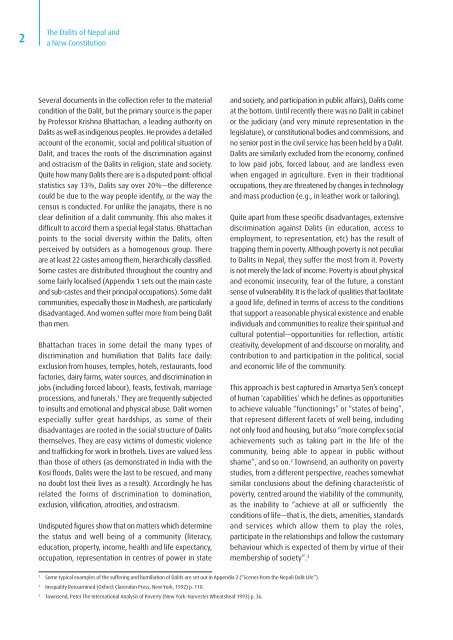The Dalits of Nepal and a New Constitution - ConstitutionNet
The Dalits of Nepal and a New Constitution - ConstitutionNet
The Dalits of Nepal and a New Constitution - ConstitutionNet
Create successful ePaper yourself
Turn your PDF publications into a flip-book with our unique Google optimized e-Paper software.
2<br />
<strong>The</strong> <strong>Dalits</strong> <strong>of</strong> <strong>Nepal</strong> <strong>and</strong><br />
a <strong>New</strong> <strong>Constitution</strong><br />
Several documents in the collection refer to the material<br />
condition <strong>of</strong> the Dalit, but the primary source is the paper<br />
by Pr<strong>of</strong>essor Krishna Bhattachan, a leading authority on<br />
<strong>Dalits</strong> as well as indigenous peoples. He provides a detailed<br />
account <strong>of</strong> the economic, social <strong>and</strong> political situation <strong>of</strong><br />
Dalit, <strong>and</strong> traces the roots <strong>of</strong> the discrimination against<br />
<strong>and</strong> ostracism <strong>of</strong> the <strong>Dalits</strong> in religion, state <strong>and</strong> society.<br />
Quite how many <strong>Dalits</strong> there are is a disputed point: <strong>of</strong>ficial<br />
statistics say 13%, <strong>Dalits</strong> say over 20%—the difference<br />
could be due to the way people identify, or the way the<br />
census is conducted. For unlike the janajatis, there is no<br />
clear definition <strong>of</strong> a dalit community. This also makes it<br />
difficult to accord them a special legal status. Bhattachan<br />
points to the social diversity within the <strong>Dalits</strong>, <strong>of</strong>ten<br />
perceived by outsiders as a homogenous group. <strong>The</strong>re<br />
are at least 22 castes among them, hierarchically classified.<br />
Some castes are distributed throughout the country <strong>and</strong><br />
some fairly localised (Appendix 1 sets out the main caste<br />
<strong>and</strong> sub-castes <strong>and</strong> their principal occupations). Some dalit<br />
communities, especially those in Madhesh, are particularly<br />
disadvantaged. And women suffer more from being Dalit<br />
than men.<br />
Bhattachan traces in some detail the many types <strong>of</strong><br />
discrimination <strong>and</strong> humiliation that <strong>Dalits</strong> face daily:<br />
exclusion from houses, temples, hotels, restaurants, food<br />
factories, dairy farms, water sources, <strong>and</strong> discrimination in<br />
jobs (including forced labour), feasts, festivals, marriage<br />
processions, <strong>and</strong> funerals. 1 <strong>The</strong>y are frequently subjected<br />
to insults <strong>and</strong> emotional <strong>and</strong> physical abuse. Dalit women<br />
especially suffer great hardships, as some <strong>of</strong> their<br />
disadvantages are rooted in the social structure <strong>of</strong> <strong>Dalits</strong><br />
themselves. <strong>The</strong>y are easy victims <strong>of</strong> domestic violence<br />
<strong>and</strong> trafficking for work in brothels. Lives are valued less<br />
than those <strong>of</strong> others (as demonstrated in India with the<br />
Kosi floods, <strong>Dalits</strong> were the last to be rescued, <strong>and</strong> many<br />
no doubt lost their lives as a result). Accordingly he has<br />
related the forms <strong>of</strong> discrimination to domination,<br />
exclusion, vilification, atrocities, <strong>and</strong> ostracism.<br />
Undisputed figures show that on matters which determine<br />
the status <strong>and</strong> well being <strong>of</strong> a community (literacy,<br />
education, property, income, health <strong>and</strong> life expectancy,<br />
occupation, representation in centres <strong>of</strong> power in state<br />
<strong>and</strong> society, <strong>and</strong> participation in public affairs), <strong>Dalits</strong> come<br />
at the bottom. Until recently there was no Dalit in cabinet<br />
or the judiciary (<strong>and</strong> very minute representation in the<br />
legislature), or constitutional bodies <strong>and</strong> commissions, <strong>and</strong><br />
no senior post in the civil service has been held by a Dalit.<br />
<strong>Dalits</strong> are similarly excluded from the economy, confined<br />
to low paid jobs, forced labour, <strong>and</strong> are l<strong>and</strong>less even<br />
when engaged in agriculture. Even in their traditional<br />
occupations, they are threatened by changes in technology<br />
<strong>and</strong> mass production (e.g., in leather work or tailoring).<br />
Quite apart from these specific disadvantages, extensive<br />
discrimination against <strong>Dalits</strong> (in education, access to<br />
employment, to representation, etc) has the result <strong>of</strong><br />
trapping them in poverty. Although poverty is not peculiar<br />
to <strong>Dalits</strong> in <strong>Nepal</strong>, they suffer the most from it. Poverty<br />
is not merely the lack <strong>of</strong> income. Poverty is about physical<br />
<strong>and</strong> economic insecurity, fear <strong>of</strong> the future, a constant<br />
sense <strong>of</strong> vulnerability. It is the lack <strong>of</strong> qualities that facilitate<br />
a good life, defined in terms <strong>of</strong> access to the conditions<br />
that support a reasonable physical existence <strong>and</strong> enable<br />
individuals <strong>and</strong> communities to realize their spiritual <strong>and</strong><br />
cultural potential—opportunities for reflection, artistic<br />
creativity, development <strong>of</strong> <strong>and</strong> discourse on morality, <strong>and</strong><br />
contribution to <strong>and</strong> participation in the political, social<br />
<strong>and</strong> economic life <strong>of</strong> the community.<br />
This approach is best captured in Amartya Sen’s concept<br />
<strong>of</strong> human ‘capabilities’ which he defines as opportunities<br />
to achieve valuable “functionings” or “states <strong>of</strong> being”,<br />
that represent different facets <strong>of</strong> well being, including<br />
not only food <strong>and</strong> housing, but also “more complex social<br />
achievements such as taking part in the life <strong>of</strong> the<br />
community, being able to appear in public without<br />
shame”, <strong>and</strong> so on. 2 Townsend, an authority on poverty<br />
studies, from a different perspective, reaches somewhat<br />
similar conclusions about the defining characteristic <strong>of</strong><br />
poverty, centred around the viability <strong>of</strong> the community,<br />
as the inability to “achieve at all or sufficiently the<br />
conditions <strong>of</strong> life—that is, the diets, amenities, st<strong>and</strong>ards<br />
<strong>and</strong> services which allow them to play the roles,<br />
participate in the relationships <strong>and</strong> follow the customary<br />
behaviour which is expected <strong>of</strong> them by virtue <strong>of</strong> their<br />
membership <strong>of</strong> society”. 3<br />
1<br />
Some typical examples <strong>of</strong> the suffering <strong>and</strong> humiliation <strong>of</strong> <strong>Dalits</strong> are set out in Appendix 2 (“Scenes from the <strong>Nepal</strong>i Dalit Life”).<br />
2<br />
Inequality Reexamined (Oxford: Clarendon Press, <strong>New</strong> York, 1992) p. 110.<br />
3<br />
Townsend, Peter <strong>The</strong> International Analysis <strong>of</strong> Poverty (<strong>New</strong> York: Harvester Wheatsheaf 1993) p. 36.








![g]k fnsf blntx? / gofF ;+l jwfg](https://img.yumpu.com/49483602/1/184x260/gk-fnsf-blntx-goff-l-jwfg.jpg?quality=85)



![+ljwfg;ef, /fHosf]k'g](https://img.yumpu.com/41604075/1/184x260/-ljwfgef-fhosfkg.jpg?quality=85)




